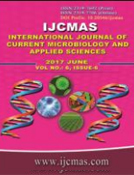


 National Academy of Agricultural Sciences (NAAS)
National Academy of Agricultural Sciences (NAAS)

|
PRINT ISSN : 2319-7692
Online ISSN : 2319-7706 Issues : 12 per year Publisher : Excellent Publishers Email : editorijcmas@gmail.com / submit@ijcmas.com Editor-in-chief: Dr.M.Prakash Index Copernicus ICV 2018: 95.39 NAAS RATING 2020: 5.38 |
One of the most important uses of the Gram stain is to evaluate the quality of expectorated sputum received for routine bacteriological culture. An acceptable sample yields less than 10 squamous epithelial cells per low power field. The simplest and least expensive sample for the diagnosis of lower respiratory infections is expectorated sputum. The utility of this approach is the subject of controversy, as the sample is contaminated by oropharyngeal flora as it passes through the mouth. To evaluate the importance of sputum microscopy and its correlation with culture in sputum samples from LRTIs and its antibiotic sensitivity pattern. 1019 samples were taken for the study. Each stained smear was examined microscopically, and the cellular components were evaluated. Those samples which satisfied Bartlett’s criteria were processed by standard protocols. According to Bartlett’s screening criteria 552 (54%) were accepted and 467 (46%) samples were rejected from 1019 samples. Potential pathogens were recovered from 450 (81.6%) samples out of 552 accepted samples. The most common organism isolated was Streptococcus pyogenes, followed by Klebsiella spp., followed by Pseudomonas spp., Staphylococcus aureus, Escherichia coli, Citrobacter koseri, Enterobacter spp. Most of the isolates were found to be susceptible to Amikacin, followed by Gentamycin, and most of the isolates were resistant to Ampicillin.
 |
 |
 |
 |
 |